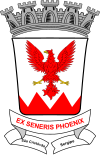São Cristóvão
| São Cristóvão | |||
|---|---|---|---|
| Bairro | |||
| Bairro de São Cristóvão | |||

São Francisco Square, São Cristóvão
|
|||
|
|||
 Location of São Cristóvão in the State of Sergipe |
|||
| Location in Brazil | |||
| Coordinates: 11°00′54″S 37°12′21″W / 11.01500°S 37.20583°W | |||
| Country | Brazil | ||
| Region | Northeast Region | ||
| State |
|
||
| Founded | January 1, 1590 | ||
| Government | |||
| • Mayor | Rivanda Batalha | ||
| Area | |||
| • Total | 436.863 km2 (168.674 sq mi) | ||
| Elevation | 47 m (154 ft) | ||
| Population (2014 (est.)) | |||
| • Total | 85,814 | ||
| • Density | 196.43/km2 (508.8/sq mi) | ||
| Time zone | UTC-3 | ||
| Postal Code | 49100 | ||
| Official name | São Francisco Square in the Town of São Cristóvão | ||
| Type | Cultural | ||
| Criteria | iii, vi | ||
| Designated | 2010 (34th session) | ||
| Reference no. | 1272 | ||
| State Party | Brazil | ||
| Region | Latin America and the Caribbean | ||
São Cristóvão (Portuguese pronunciation: [sɐ̃w kɾisˈtɔvɐ̃w], Saint Christopher) is a Brazilian municipality in the Northeastern state of Sergipe. Founded at the mouth of the Vaza-Barris River on January 1, 1590, the municipality is the fourth oldest settlement in Brazil. São Cristóvão is noted for its historic city square, São Francisco Square, and numerous early colonial-period buildings. The 3 hectares (7.4 acres) site was designated a UNESCO World Heritage Site in 2010.
São Cristóvão covers 437 square kilometres (169 sq mi), making it the third largest settlement in the state of Sergipe behind Aracaju and Nossa Senhora do Socorro. Its population is 85,814 (est. 2014) and has a population density of 196.43 per km2 (508.8/sq mi). São Cristóvão is home to the Federal University of Sergipe, which was established in 1968.
São Cristóvão was established by the Portuguese (in a time when Portugal, Spain and the Naples kingdoms were under the rule of Philip II of Spain) as one of the first colonization attempts in Sergipe, which makes the city the fourth oldest one in Brazil. In 1590 the Portuguese sent Cristóvão de Barros to both subjugate the region to colonial rule and establish a safe trading port between Salvador and Pernambuco. De Barros quickly and violently defeated the local population, which consisted of people of mixed Tupinambá and French heritage who maintained a trade in Brazilwood. As a symbol of his victory De Barros founded a small village named for his patron saint, Saint Christopher.
...
Wikipedia



